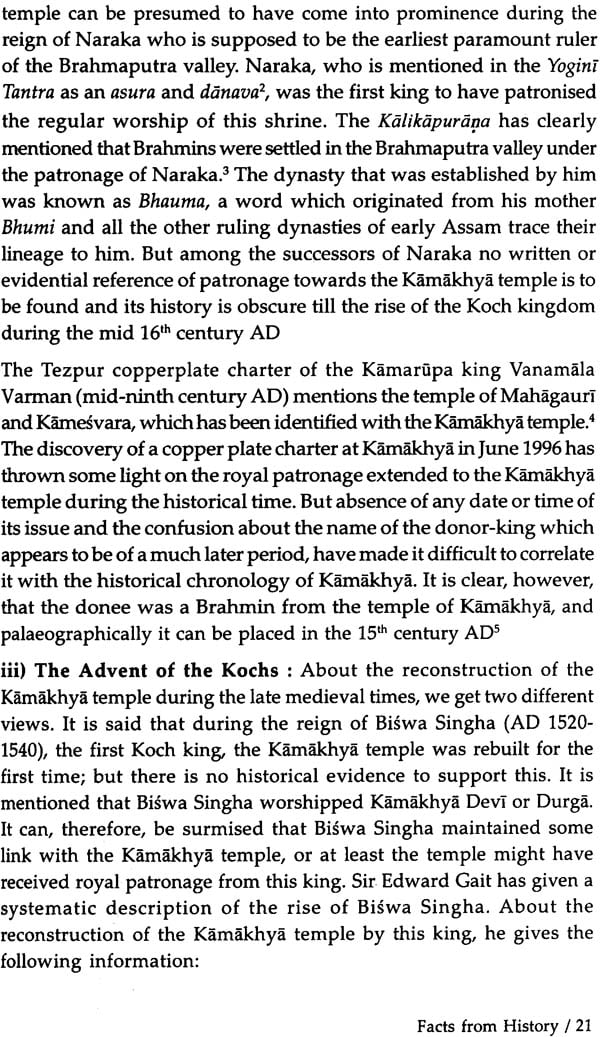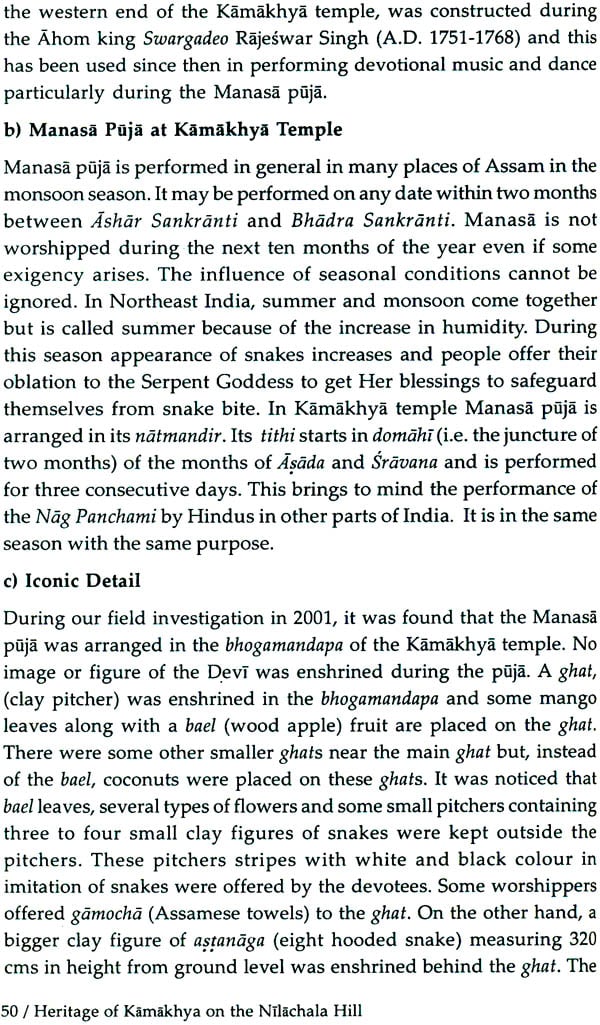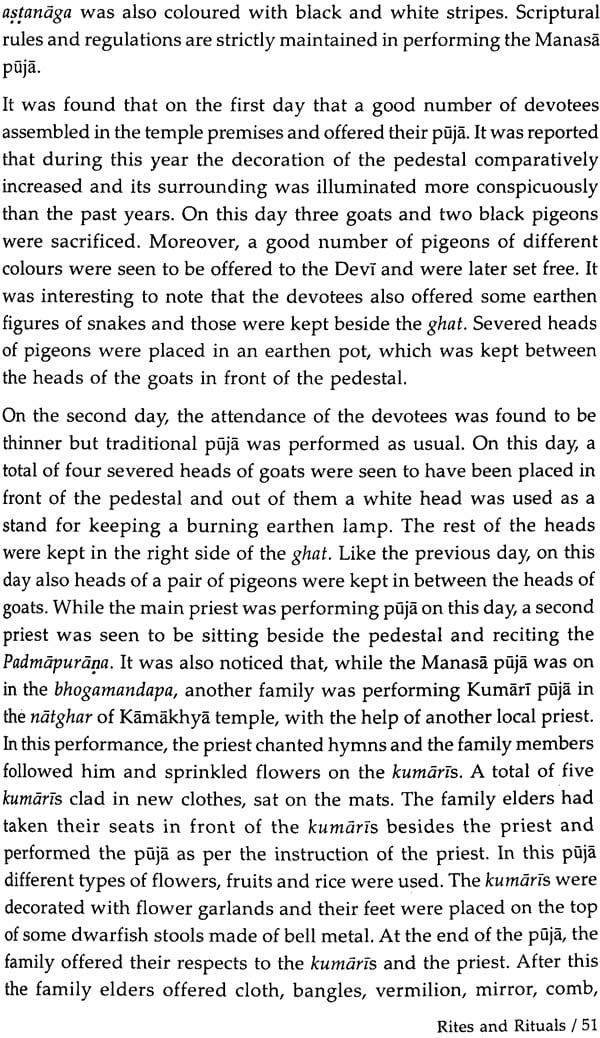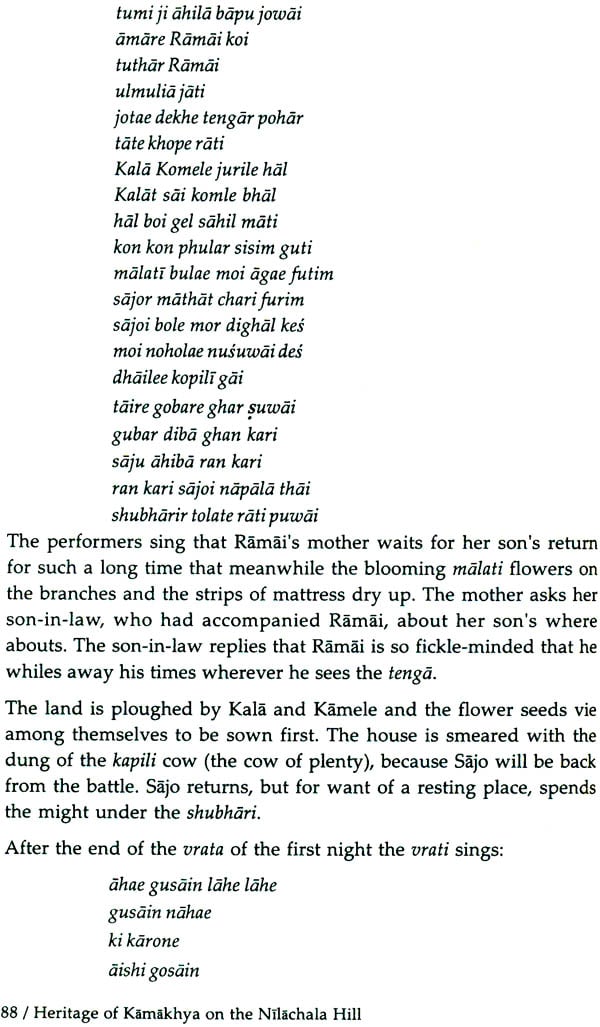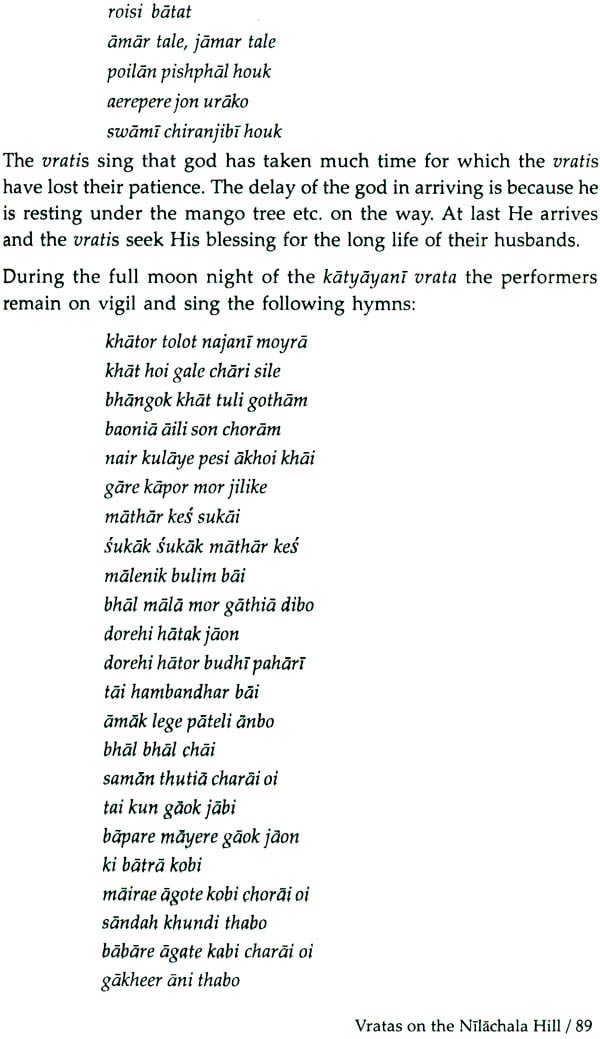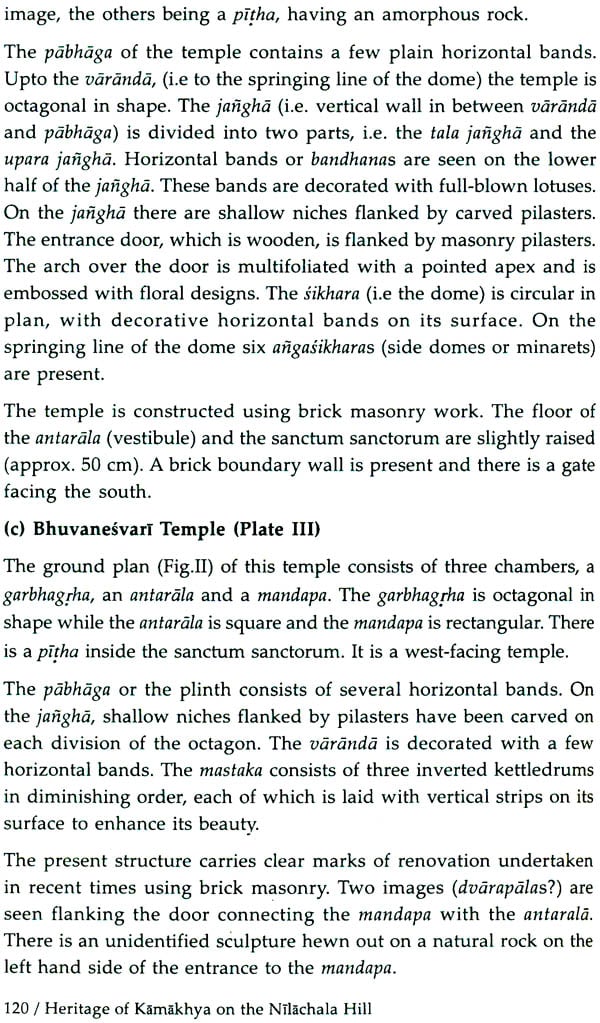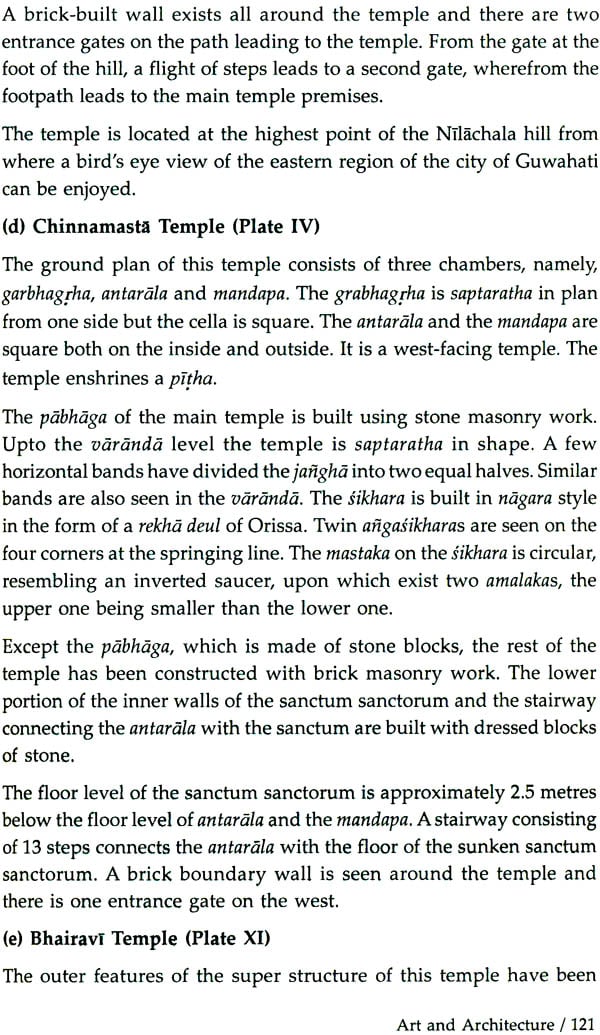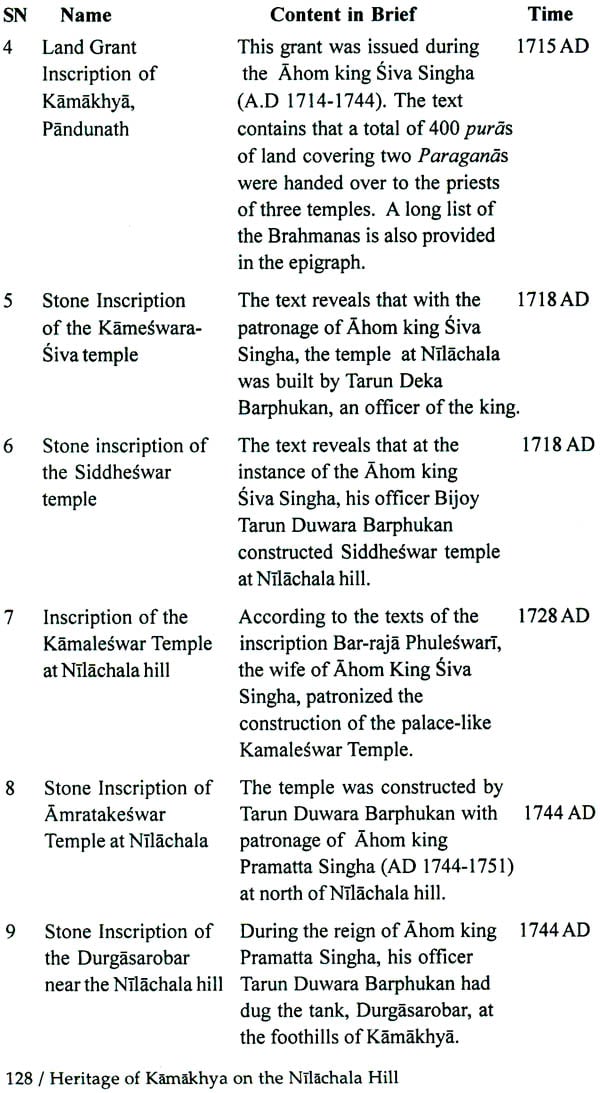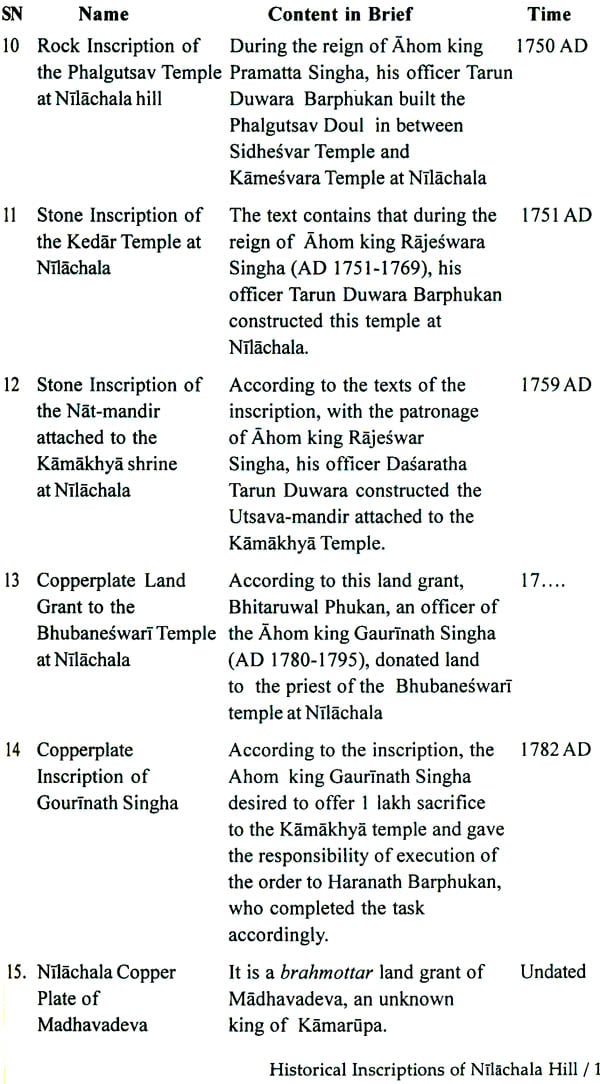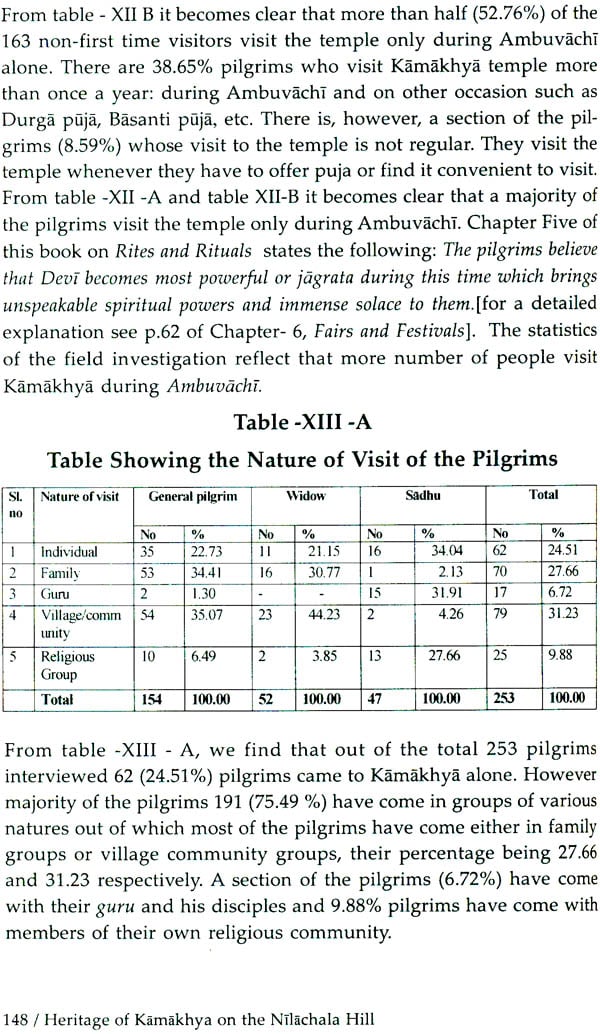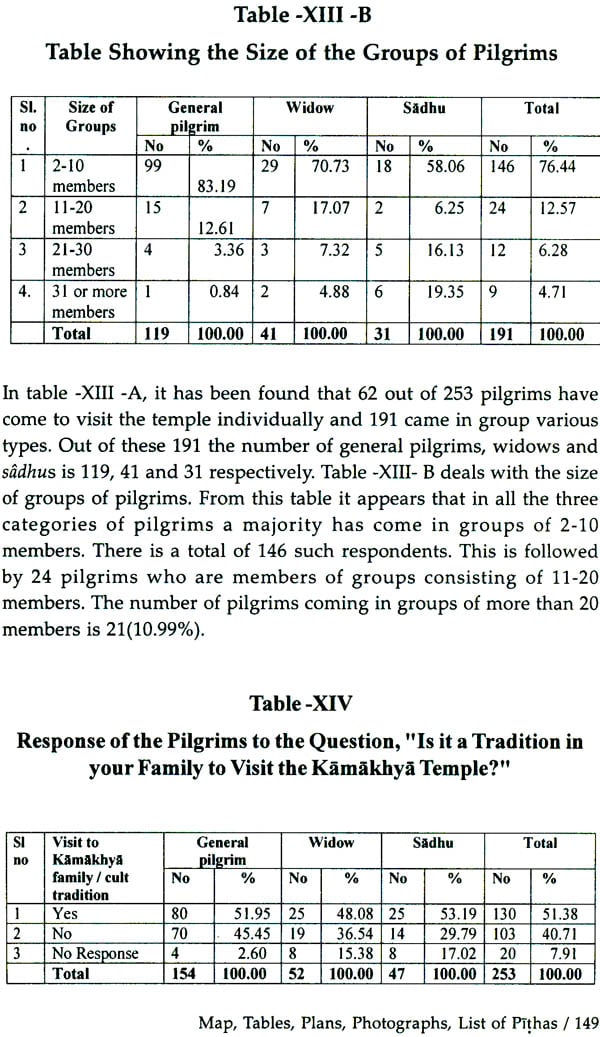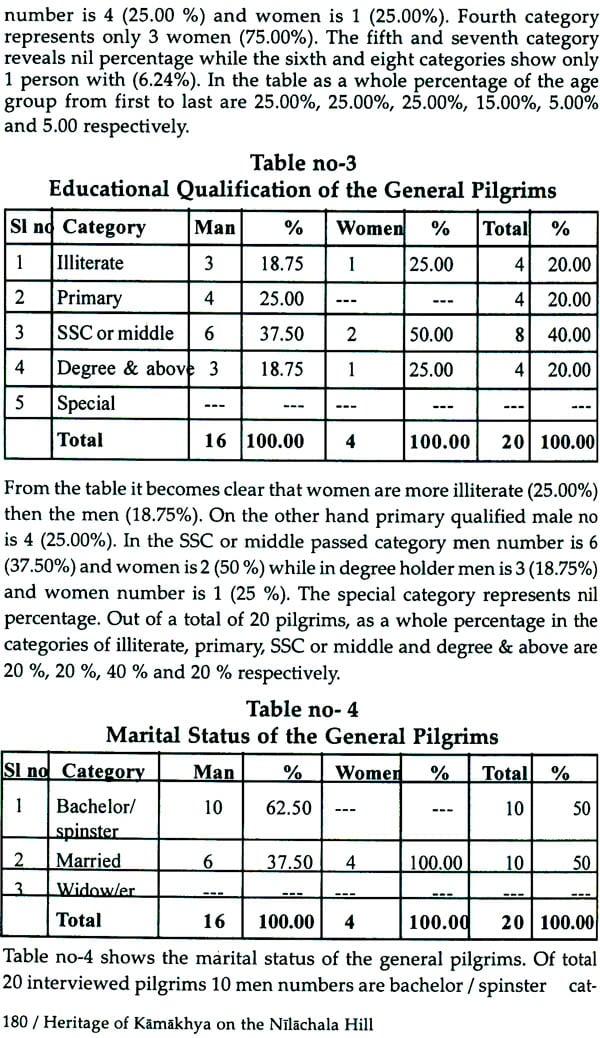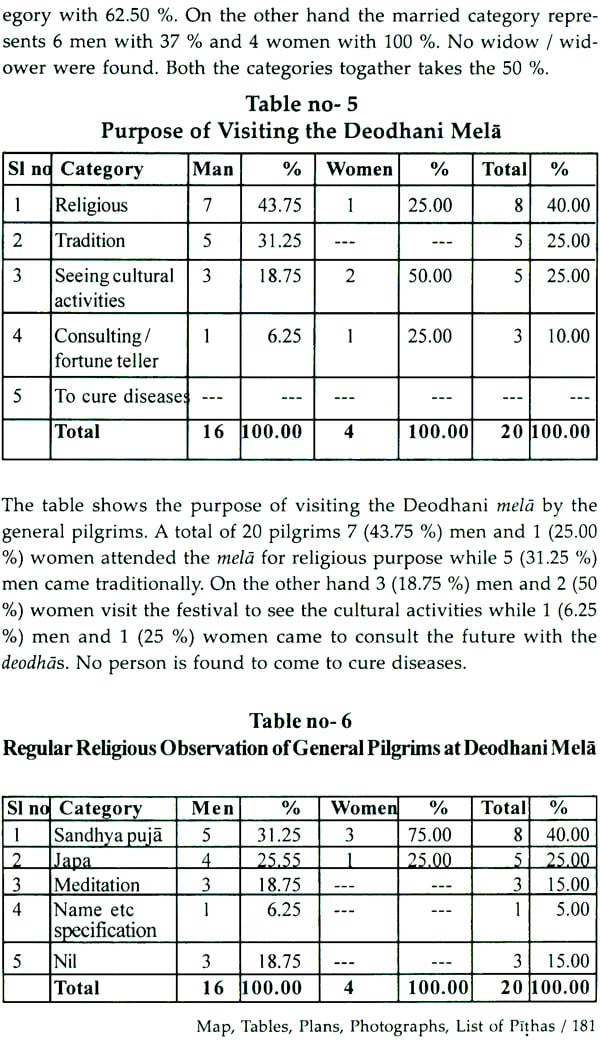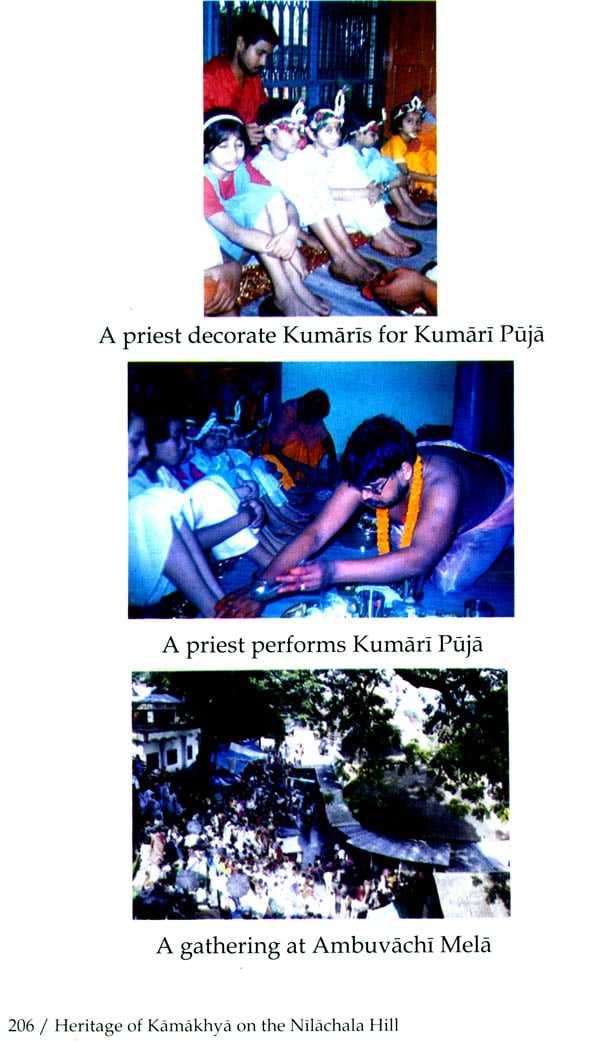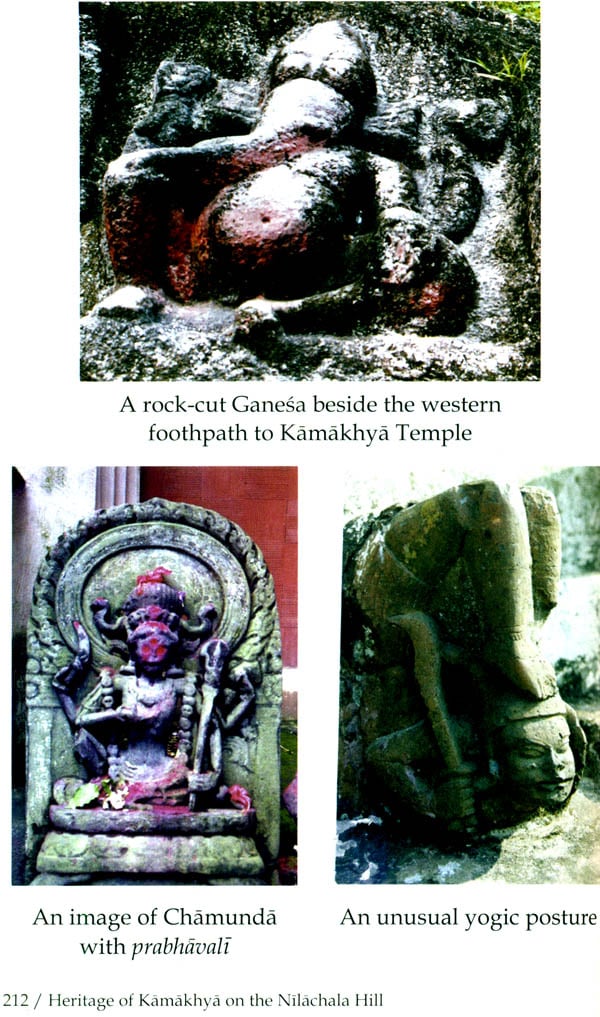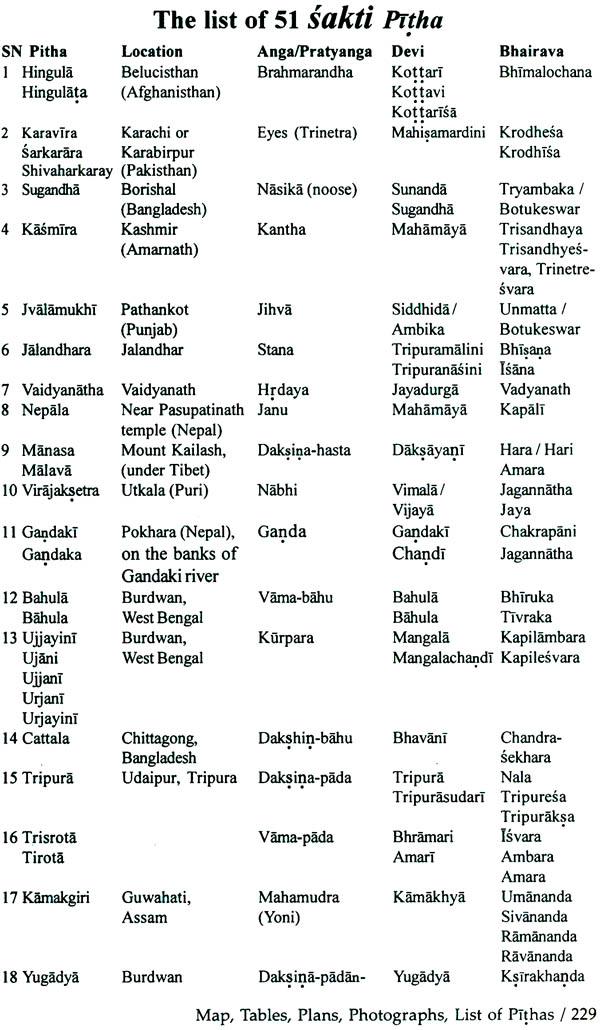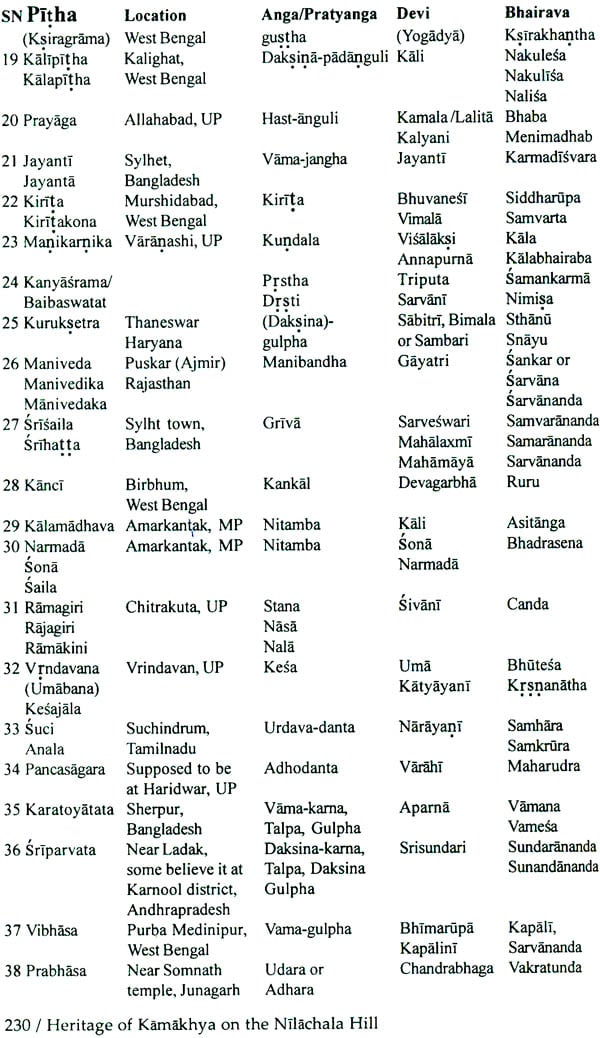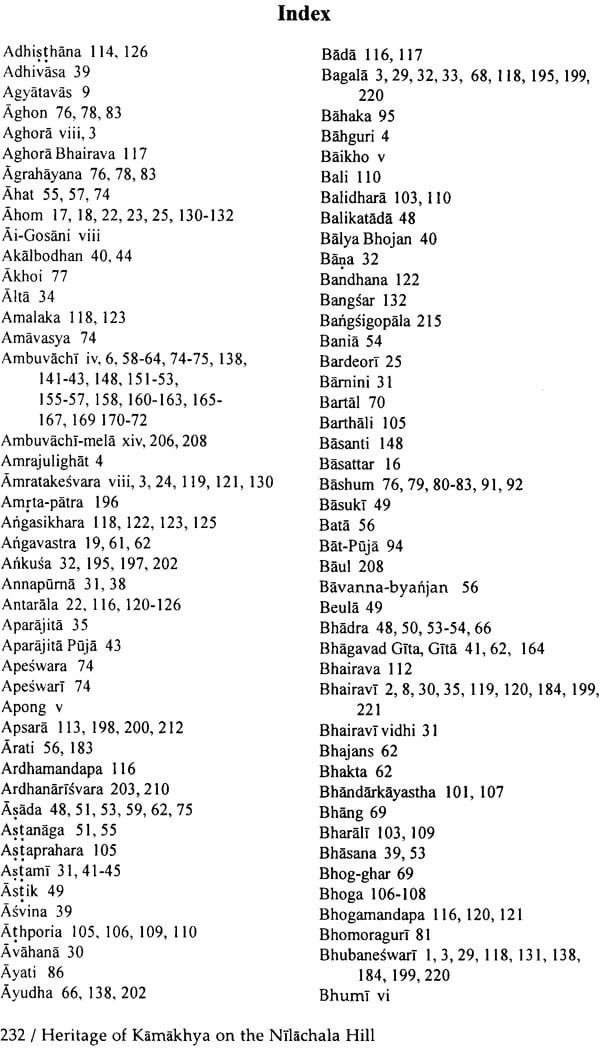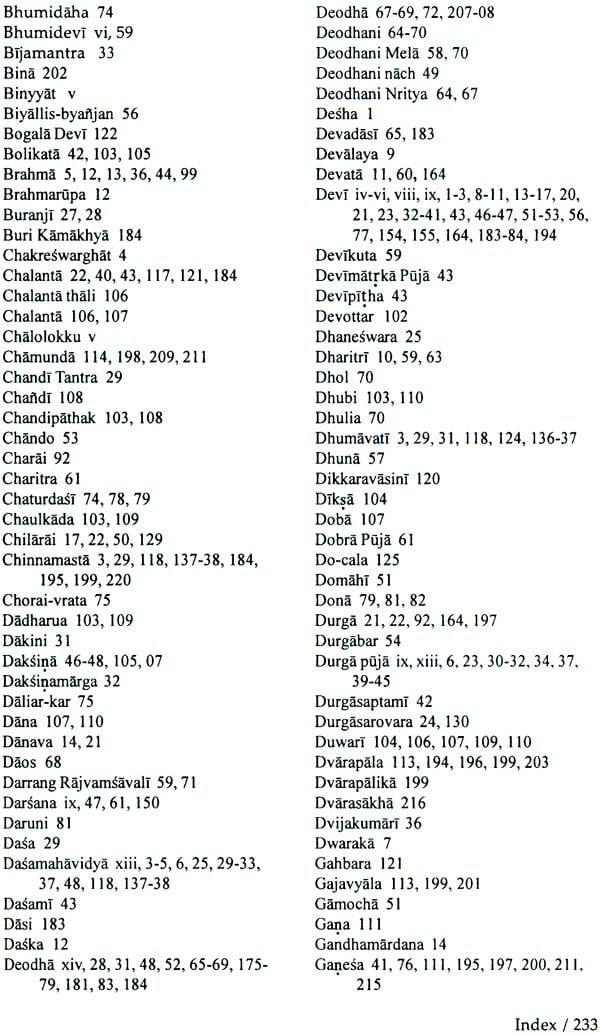
Heritage of Kamakhya on The Nilachala Hill (Based on Field -Investigation): A Rare Book
Book Specification
| Item Code: | NAF224 |
| Publisher: | VIVEKANANDA KENDRA INSTITUTE OF CULTURE |
| Language: | English |
| Edition: | 2010 |
| ISBN: | 81892489490 |
| Pages: | 258 (50 Color Illustrations) |
| Cover: | Paperback |
| Other Details | 8.5 inch x 5.5 inch |
| Weight | 310 gm |
Book Description
Represented as a svayambhu atop the Nilachala Hill in Guwahati, Assam, Kamakhya is one of the most important of the 51 Shakti Pithas. In the late 90s VKIS’s research team asked itself a question What draws thousands of people to the Kamakhya throughout the years especially during the Ambuvachi Mela?
Thus began the inquiry that went through various phases of research data collection on rituals observed at the Kamakhya documentation of the Ambuvachi and deodhani mela, interaction with people associated with the Kamakhya pandas and pilgrims tourists and traders as well as interaction with people of various communities from the hill and the plains. All this led to the present book, The Heritage of Kamakhya on the Nilachala Hill. The chapter relate its history both oral and recorded its rites and rituals fairs and festivals art and architecture inscriptions and sculpture all of which prove that while the tradition of worship to Her is itself not datable Kamakhya has been and continues to be a unigying symbol in the religio-cultural life of various communities and traditions including the Saiva the Vaisnav the Ganapaty. Moreover VKIC’s study indicates an abiding relationship amongst dwellers of the forests hills villages and cities. This symbiotic relationship of the socio-cultural continuum indicates that in many respects mother Kamakhya is the Mother of us all.
The Kamakhya temple is the most potent symbol of the heritage and religious beliefs of a major part of the population of this region of India. It is not only a place of worship but a site of immense archaeological and sociological value. Therefore this initiative by the Vivekananda Kendra institute of culture attains much importance in the recording of the literal history and sociological commentary of Northeast India.
VKIC has been documenting various aspects of the Kamakhya including the sites, practices and religious rites and festivals for many years now. These have been presented in seminars and various foras and have been very well received. We have now decided to collate and record of our work. I am proud and honoured to have been associated with this project.
On behalf of Vivekananda Kendra Institute of Culture I would like to thank all the volunteers students learned advisors and the public who have supported our work. We continue to look forward to their association with us.
We hope this book will be well received by the public. In no way is our work complete on the Kamakhya. But is we believe a small but significant step.
Goddess Kamakhya of Kamarupa is represented as a svyambhu stone yoni on the top of the Nilachal or Nilaparvata (the blue hill) in Guwahati, Assam. Sanctified by Her presence the entire range of cosmic Energy. Since it is a vibrant saktiptiha with many incarnations of the mother the hill abounds in temple including rock-cut images and cared spots. These coupled with narratives from traditionally recounted history pervade this hilly region making it a religio-spiritual site of great importane.
It is therefore a matter of study and research as to how this ruggedly sacred area has inspired and continues to draw the devout from the length and breadth of India. Here lies the importance of the presiding deity who is also identified as the Mother earth. Incidentally, ambuvachi, signifying the yearly period of menstruation of the Devi, is one of the most significant occasions observed at Kamakhya when thousands of pilgrims from different parts of our country and abroad assemble to participate in the rituals. Such is the reverence that famers do not till their fields on these days the devout refrain from undertaking programmes of significance as a period of seclusion of the Devi.
The earth is perceived and revered as the Mother among all the indigenous communities of the world and more so in India. Research conducted by Vivekananda Kendra Institute of Culture (henceforth VKIC) shows that as in all the indigenous communities of India in Northeast India too the earth is considered as the sustainers of humanity and as such it should not be exploited but respected as Life-giver. Thus many revere the earth upon which the very survival of human beings depends as Mother and worship her as the Goddess of cultivation and fertility. Each step in raising crops right from the stage of tilling the land sowing seeds stage when the corn starts to but to harvesting is preceded by a ritual. Probably this intrinsic conviction or shraddha inspired the communities to recognize Kamakhya on the Nilachala as the Supreme benefactor who help her devotees in the fulfilment of their desire.
It is interesting to note that earth as Goddess of life [many call it fertility] is accepted directly or indirectly by all the indigenous communities of India. Northeast India is no exception. The Rabhas worship Baikhu Devi the earth goddess to get blessing for good crop and wealth (Tribes of Assam Ed. B.N Bordoloi etc Guwahati 1994,). The Meiteis or Manipur consider a natural phenomenon of the union of the sky father and earth mother as the creator of their progenitor (Traditional Customs and Rituals of Northeast India Vol. I, VKIC, Guwahati 2002,). The Lai Haraoba the greatest festival of the Manipuris is associated with worship of the earth (Traditional customs and Ritual of Northeast India Vol. I). A section of the Nagas also celebrates the Luingaini festival on 15 February every year for a bountiful harvest. (Traditional customs and Rituals of Northeast India, Vol. I)
Communities in Arunachal Pradesh too have this tradition. For instance among the Tagins, Si-Donyi is celebrated. Si is the Earth and Donyi the sky. The Adis offer binyyat (ginger and apong-rice beer) to kiine Nane the Goddess of Prosperity during the solung festival. Similarly in the Noctes Chalo Lokky, the Wanchos’ Oriah, the Singphos’ Shapawng-Yawng, the Mishmis Rhe the Nyishis Nyokum the Apatanis’ Dree, the sherdukpens and Monpas’ Losar, the Earth is revered as Mother. (Festivals of Arunachal Pradesh, Quest Vol. III No. 1). The worship of mother goddess Kamakhya is also part of the same vision in his Keynote address on Traditional customs and Rituals of Arunachal Pradesh Prof A C Bhagabati gives the perspective thus.
The cult of the Mother Goddess, worship of Siva concepts of gods representing natural forces like rain and wind and the celestial bodies have nearly all been absorbed by Hinduism from the indigenous culture… (Tribal) beliefs and practices provided the substratum for the growth and development of Hinduism as we know it today. In the same way (Tribal) religions have also been receptive of ideas and practices emanating from Hinduism… Religion is basically a reflection of social situations (Traditional customs and Rituals of Northeast India, Vivekananda Kendra Institute of Culture, Guwahati, Vol. II).
Sandhya Jain echoes the sentiment:
This agility with which tribal gods overcome their Native forest or mountain environment and acquired all India eminence symbolizes an eternal verity of the Hindu spiritual tradition. Notable example of this outward mobility include the pan Indian (tribal) Phenomenon of worshiping snakes (naga, nagdevatga) and the earth mother (Devi), which permeates equally the forest community village regional and classical ethos. But as K S Singh points out the natural of the sacrifice offered to her (goat, fowl, buffaloes) is consistent with ancient tribal practice and betray her tribal origins… in innumerable temples across the length and breadth of the country including large cities and metropolis one finds to this day the autochthonous practices of revering stones or pebbles (symbols of Devi) besides the main image in the garbha griha (sanctum Santorum) (Jain Sandhya Adi Deo Arya Devata – A Panoramic view of Tribal Hindu Culture interface, Rupa & Co New Delhi 2004).
We find mention both in the Kalikapurana and the copper-plate charters of the early Kamarupi kings that Naraka the Progenitor of the three ruling families of Pragjyotisa-Kamarupa was the son of Bhumidevi (bhumi is synonymous with the earth) who established the Bhauma line of rulers after Videha invaded pragjyotisa killed its Kirata King Ghataka started his rule from the city of pragjyotispur and took over management of the shrine of Kamakhya. The said Purana also mentions that this new ruler brought dvijas (Brahmins) and settled them in this kingdom which naturally helped in the blending of Kiratic practices with the Vedic rites. As Jain puts it:
The colonial era unleashed a genre of Scholarship that portrayed India’s … tribal population as an aggregate of primitive social groups that were separate from and beyond the pale of mainstream Hindu society. Scholars are now looking in askance at this established orthodoxy as even the most cursory mapping of the spiritual-culture landscape reveals a deep symbiotic relationship between (People of the forest regions and those of the urban ones) from very ancient times…
Redfield analyzed this interaction: this… is perhaps the most important conclusion of recent anthropological studies of Hinduism… the unity of Hinduism… is to be found in… the continuities that can be traced in the concrete media of song dance play sculpture Painting religious story and rites that connect the ritual and beliefs of the villagers with those of the townsman and urbanite one region with another and the educated with the uneducated.
The nilachal thus serves as an excellent example of the vanavasi gramavasi nagarvasi Socio-religious continuum mischievously portrayed by the British and reiterated to this day by west centric scholars as a Hindu tribal / animist (sic) divide.
Even the etymology of the name Kamakhya beautiful exemplifies this continuum. The Rg Veda regards kama as essentially a process of creation; while the Atharva Veda sees it as a procreative process. Dr B. Kakati in his book titled The Mother Goddess Kamakhya (First Edition, Guwahati, 1948) suggests possible origins of the world Kamakhya. He states: As the innumerable names of the goddess are mostly names of local goddess both Aryan and non Aryan it may be suspected that the formation kama in Kamakhya is of extra Aryan origin.
Since Kamakhya is a deity who derives from and sustains traditions of several communities her name signifies a variety of aspects to various communities. For Bod-Kacharis she is Kham-Maikha- the old / ancient mother to the Garos Nuting Muring – the energy behind creation. She is revered by the Jaintias the Ahoms the Meities the tipras the Rabhas to name a few. The strides made in research reveal more finding.
R.M. Nath….. believes that the name derives from the khasi ka-mei-kha. The prefix ka is for the feminine, ka-mei-kha is power. Kha also means one who brings forth; hence ka-mei-kha is the primordial Female principle. Hamlet Bareh feels Kamakhya could be a form of the khasi ancestral mother ka-mei-kha as the Guwahati region may have originally been khasi territory. The Khasi female principle of creation is ka-Blei Synchar, who is the energy behind the supreme being U Blei Nonghew a relationship that echoes the ones between sakti and siva. The yogini Tantra Shows that the Khasis were a Kirta tribe (Sidhesi Yogini Pithe dharmah Kairatijahmatah) (Singh G P, Kiratas in Ancient India, Gian Publishing House Delhi 1990).
Hitherto Scholars held that (so-called) Aryas from the plains expelled the Austric Speakers of the hills but adopted their religious beliefs, including the mother Goddess Ka-Mei-Kha, Ali Gosani or Yoni Devi. P C Choudhary insisted that the Yoni-goddess migrated to Assam with the migration of the Austric or the matriarchal tribes like khasis and the Garos… Naraka became respsonsible for the foundation of Devi Worship in Kamarupa.
But given the overwhelming evidence of Yoni worship from primeval times and the incongruity of the hypothesis that the (so-called) Aryas expelled native groups from various regions but everywhere retained their (native-groups) dhrama and culture this view seems unworthy of colonial imprint from these premises. (Jain Sandhya Adi deo Arya devata A panoramic view of tribal Hindu culture insterface, Rupa & Co. New Delhi.
Another interesting feature of the Nilachal is the Siva temples. As per the concept of Siva Sakti a divine power is complete and effective only when its complementary exists side by side. Hence in addition to the tem incarnations of Devi the Nilchala hill contains five Bhairavas whose temples are Kameswars Siddheswar Aghora, Kotlinga and Amratakeswara. Therefore the devotees invariable offer homage to Siva by visiting at least one Siva temple after having darsana of the Devi in the main temple.
It is interesting how ways of life and living co-mingle with some of the rituals at the different shrines at Kamakhya. The worship of serpent goddess Manasa in Kamakhya as an annual festival (Nag Panchami in other parts of India) usually occurs in the month of sravana or mid July when northeast India witness maximum incidents of snake-bite due to heavy rain and inundation. Kachu (arum a vegetable which is soaked in water and kept overnight) are compulsorily offered as prasada along with other offerings. Incidentally the famers while goint to the field during this season are accustomed to taking this cold rice early in the morning. This custom which is part and parcel of the life of the devotees must have come from this habit. Use of selective vegetables for sacrifice such as Kuhiyar (Sugar-cane) Komora (water-gourd) kachu (arum) during Durga Puja along with pigeon, duck, goat, buffalo, etc also speaks of such customs among the wet-rice cultivators.
Many of these communities continue to maintain the ancient relationship with the temple. This is borne out by the fact that to this day the offerings including sacrificial animal made to the Devi during festive occasions are sent as prasada to them. Thus Kamakhya has been the mother Divine through whom we know better of her children in the northeast.
The above analysis clearly shows that kamakhya on the Nilachal served as the unifying factor for the religio-culture beliefs of different communities of the ancient kingdom of Kamarupa. Some of the legends associated with this Saktipitha are the oldest in Northeast India and so is the case with its history. Even the archaeological evidence lying scattered on this part of the country. Thus Nilachal can be regarded as an eye-witness not only to architectural changes but to the overall evolution of India’s history.
Therefore, VKIC took up the project of Kamakhya on the Nilachal Hill in order to uncover all aspects associated with it. For the convenience of field documentation and investigation we organized various aspects of this project into some major sections which are noted below:
• History
• Religion
• Festivals
• Archaeology
• Demography
• Revenue System
• Folklore
• Literature
• Temple Management
• Architecture
Starting with 1999, the documentation work for this area has by now covered some of the above aspects the details of which have been incorporated into this volume. The field work was planned in consultation with Dr Sunil Kr Barua, Former Assistant Director, Census and member VKIC research council who has wide experience in this line. Documentation was undertaken by student volunteers of this institute under the supervision of a few experienced resource persons including college teachers primarily of the anthropology discipline. Those who guided the volunteers are Dr Eliza Medhi Lecturer in cotton college, Guwahati, Smt Jyotirupa sarma Lecturer Aryavidyapith College, Guwahati Sri Manish Singhal, former secretary VKIC Sri Dilip Gosai former in charge VKIC documentation Sri Dipankar Mahanta former Associate Director VKIC. Student volunteers included Madhurjya Bordoloi Ankur Acharjya Anupam Barua Ruma Sarma Julie Barooah Gitanjali Das Minu Das Karabi Goswami Amit Sarma Biswajit Bharati Manisha utpalam Borati, subir and Bornali. Special mention needs to be made utpala, Borati, Subir and Bornali. Special mention needs to be made of Sri Prabal Kr. Das now staff sculptures all of which are of great historical and architectural importance. Late Pranjal Saikia also contributed to the field investigations. Of particular mention is Dr Sukanya Sharma, now Assistant Professor Dept. of Humanities and social science IIT-Guwahati who in addition to field documentation prepared ground plans of all the temples as well as the map on Kamakhya showing the location of temples ponds etc for which she deserves our gratitude.
It is heartening to note that the Managing committee of the Kamakhya temple and more particularly the late Shri Paran Chandra sarma Shri Darani Kanta Deva Sarma Dr. Jwalaprasad Sarma Shri Amiya Bhandar Kayastha Shri Basanta Dev Sharma (priest Bagala Temple) and Shri Ganga Prasad Sarma extended their unstinted co-operation in conducting the field works smoothly. The advice and guidance offered by Shri Anup Prasad Sarma and Pranab Sarma of Duwargarilla from time to also immensely helped in going ahead with our work. The cooperation extended by respected Smt Bina Devi with her school mate Smti Saranani Devi and daughter and son in law associated with rites and rituals in the families of the priests needs special acknowledgement. We also put on record the assiduous zeal and enthusiasm shown by Sri Bosanta Kumar Bora the Research Associate of this institute. He explored investigated and collected data which were not readily available by sincerely contacting and pursuing different resource persons and by making door to door services rendered by Sri G N Bhuyan former director, directorate of archaeology Assam and kum. Sujataha Nayak, Secretary, VKIC in revising the texts of the different chapters most meticulously with their cholarly acumen and proficiency. We express our gratitude to Prof. AC Bhagabati former vice chancellor Arunachal University [at present Rajiv Gandhi University] and member VKIC Research Council. In these days when emphasising diversity Separateness has become the norm Prof. Bhagabati has encouraged us to look at how Mother Kamakhya unifies communities and that really in the vision of our Rishis, Siva, Sakti and Visnu are Divine expressions of the one Indivisible Truth.
It needs mention in this context that this volume contains whatever materials our field investigator could collect. It therefore cannot be taken as complete and comprehensive in all respects. However the data projected here are form first hand sources which may help both readers and researchers get and idea about what Kamakhya as a Saktipitha stands for. We sincerely hope this effort from our side will trigger more interest in understanding our history and our cultural linkages in the right perspective. May the great mother kamakhya bless all such efforts.
| List of Illustration | VIII | |
| Table of Transliteration and Key to Pronunciation | X | |
| Foreword | XI | |
| Preface | XII | |
| Chapter 1 | The Nilachala Hill | 1 |
| I) | Geographical Features | |
| II) | Legends Associated with the Nilachala Hill | |
| III) | A Place of Pilgrimage | |
| IV) | Communication | |
| V) | Demographic Details of Inhabitants | |
| VI) | Residential Buildings Health & Hygiene | |
| Chapter 2 | Kamakhya Episodes in Traditional History | 7 |
| I) | Role of Tradition in Understanding History | |
| II) | Oral Legends | |
| III) | Legends in the Kalikapurana | |
| IV) | Legends in the Yogini Tantra | |
| V) | Historical Legends | |
| Chapter 3 | Fact from History | 20 |
| I) | Inference from the Kalikapurana | |
| II) | From Legend to History | |
| III) | The Advent of the Kochs | |
| IV) | Rebuilding the Kamakhya Temple | |
| V) | Ahom Patronage | |
| VI) | Ravages of the Great Earthquake | |
| VII) | Dubious Generosity | |
| Chapter 4 | Dasamahavidya or the Ten Incarnations of Devi | 29 |
| Chapter 5 | Rites and Rituals | 34 |
| I) | Kumari Puja | |
| II) | Durga Puja | |
| III) | Kali Puja | |
| IV) | Manasa Puja | |
| Chapter 6 | Fairs and Festivals | 58 |
| I) | Ambuvachi mela | |
| II) | Deodhani-nritya | |
| III) | Janmasthami | |
| Chapter 7 | Vratas on the Nilachala Hill | 73 |
| I) | Different Types of Vrata | |
| II) | Satha Vrata | |
| III) | Katyayani or chorai vrata | |
| IV) | Doul Vrata or the Event of Penance and worship | |
| Chapter 8 | Sevaits of Kamakhya Temple | 100 |
| Chapter 9 | Sculptures on the Nilachala Hill | 101 |
| I) | Sculptures on the Body of the Temples | |
| II) | Sculptures on the Gateway | |
| III) | Isolated Images | |
| IV) | Rock-cut images | |
| Chapter 10 | Art and Architecture | 114 |
| I) | Early Phases | |
| II) | Living Temples and Shrines | |
| III) | Architectural Features of Standing Temples | |
| Chapter 11 | Historical Inscription of Nilachal hill | 127 |
| Chapter 12 | Map, Table, Plans, Photographs, List of Pithas | 31 |
| A. | Map | |
| B. | Table | |
| I) | Iconographical Data of Dasamahavidya | |
| II) | Table of Ambuvachi-mela, 1999 | |
| III) | Table of Ambuvachi-mela, 2002 | |
| IV) | Table of Deodhani Mela, 2001 | |
| V) | Names of Deodhas, 2001 A D | |
| C. | Ground-Plan of Temples | |
| D. | List of Documented Photographs | |
| E. | Photographs of Festivals, Sculptures and Architecture | |
| F. | List of Pithas | |
| Index | 232 |

